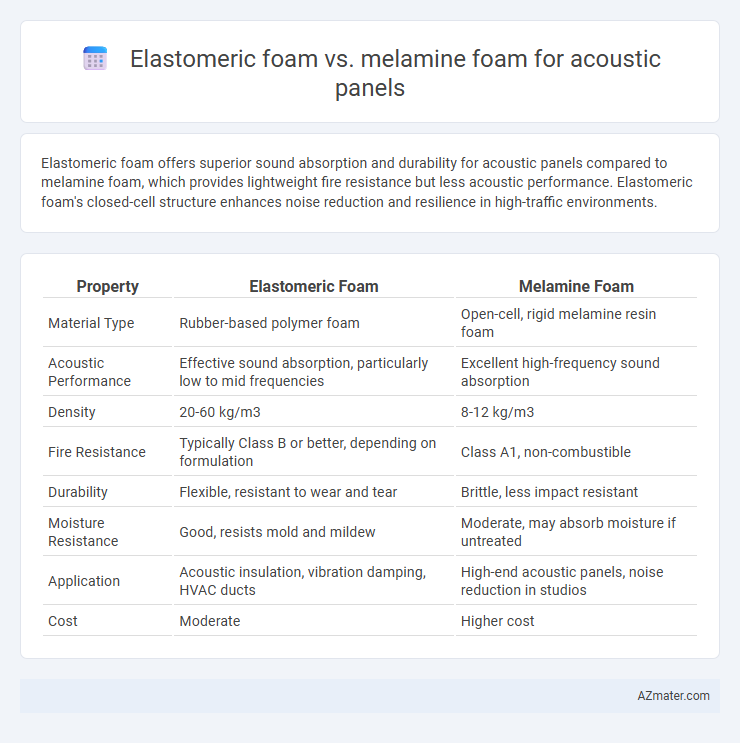Elastomeric foam offers superior sound absorption and durability for acoustic panels compared to melamine foam, which provides lightweight fire resistance but less acoustic performance. Elastomeric foam's closed-cell structure enhances noise reduction and resilience in high-traffic environments.
Table of Comparison
| Property | Elastomeric Foam | Melamine Foam |
|---|---|---|
| Material Type | Rubber-based polymer foam | Open-cell, rigid melamine resin foam |
| Acoustic Performance | Effective sound absorption, particularly low to mid frequencies | Excellent high-frequency sound absorption |
| Density | 20-60 kg/m3 | 8-12 kg/m3 |
| Fire Resistance | Typically Class B or better, depending on formulation | Class A1, non-combustible |
| Durability | Flexible, resistant to wear and tear | Brittle, less impact resistant |
| Moisture Resistance | Good, resists mold and mildew | Moderate, may absorb moisture if untreated |
| Application | Acoustic insulation, vibration damping, HVAC ducts | High-end acoustic panels, noise reduction in studios |
| Cost | Moderate | Higher cost |
Introduction to Acoustic Panel Materials
Elastomeric foam and melamine foam are prominent materials used in acoustic panels for sound absorption and noise control. Elastomeric foam offers durability and flexibility with excellent low-frequency absorption, making it suitable for various architectural environments. Melamine foam provides high-frequency sound absorption, lightweight properties, and flame retardancy, often used in studios and commercial applications for effective acoustic treatment.
What is Elastomeric Foam?
Elastomeric foam is a flexible, synthetic material known for its excellent sound absorption and thermal insulation properties, making it ideal for acoustic panels. Unlike melamine foam, elastomeric foam offers higher durability, moisture resistance, and better resilience under compression, which ensures long-lasting acoustic performance in various environments. Commonly made from materials like polyurethane or neoprene, elastomeric foam effectively reduces echo and reverberation in industrial, commercial, and residential applications.
What is Melamine Foam?
Melamine foam is a lightweight, open-cell acoustic material known for its superior sound absorption and fire-resistant properties, making it ideal for acoustic panels in environments requiring high-performance noise control. Unlike elastomeric foam, which is denser and more flexible, melamine foam offers excellent thermal insulation along with effective reduction of mid to high-frequency sound waves. Its rigid, porous structure enables efficient sound wave dissipation, enhancing room acoustics in studios, offices, and industrial spaces.
Acoustic Performance: Elastomeric vs Melamine Foam
Elastomeric foam offers superior sound absorption and noise reduction due to its closed-cell structure, effectively dampening low to mid-frequency sounds in acoustic panels. Melamine foam excels in high-frequency sound absorption thanks to its open-cell, lightweight matrix that promotes greater airflow and sound wave dissipation. Choosing between elastomeric and melamine foam depends on the targeted acoustic frequency range and specific noise control requirements of the environment.
Thermal Insulation Properties Comparison
Elastomeric foam exhibits superior thermal insulation properties compared to melamine foam due to its closed-cell structure, which effectively reduces heat transfer and maintains consistent temperature control. Melamine foam, while known for its excellent sound absorption, has an open-cell matrix that provides less thermal resistance and higher thermal conductivity. Choosing elastomeric foam for acoustic panels enhances both soundproofing and energy efficiency in buildings by delivering better thermal insulation performance.
Durability and Lifespan Differences
Elastomeric foam offers superior durability and a longer lifespan compared to melamine foam, maintaining structural integrity under repeated compression and environmental stress. Melamine foam, while effective for sound absorption, tends to degrade faster due to its brittle nature and susceptibility to moisture and mechanical damage. Elastomeric foam's resilience makes it ideal for long-term acoustic panel applications in high-traffic or variable environments.
Fire Resistance and Safety Considerations
Elastomeric foam offers superior fire resistance with high ignition temperature and low smoke emission, making it a safer choice for acoustic panels in commercial and industrial spaces. Melamine foam, while effective in sound absorption, has a lower fire retardancy and can release toxic fumes when exposed to flame. Prioritizing elastomeric foam enhances safety compliance and minimizes fire hazards in building acoustic treatments.
Installation and Maintenance Requirements
Elastomeric foam acoustic panels typically require adhesive or mechanical fasteners for installation, offering flexibility in placement and ease of cutting to fit various spaces, while maintenance involves simple cleaning with mild detergent and water to maintain acoustic performance. Melamine foam panels are lightweight and often installed using spray adhesives or hook-and-loop systems, allowing quick application but generally needing gentle handling due to their fragile structure; maintenance includes careful dusting or vacuuming to prevent surface damage. Both foam types demand moisture control to preserve integrity, but elastomeric foam tends to be more durable in humid environments, reducing long-term upkeep and replacement frequency.
Cost Analysis: Elastomeric vs Melamine Foam
Elastomeric foam typically has a higher initial cost compared to melamine foam due to its durable, flexible properties and superior noise absorption capabilities in low-frequency applications. Melamine foam offers a more budget-friendly solution with effective sound absorption primarily in mid to high-frequency ranges, making it ideal for cost-sensitive projects requiring only moderate acoustic treatment. When evaluating long-term value, elastomeric foam's resilience and moisture resistance often result in lower maintenance costs, whereas melamine foam might require more frequent replacement in demanding environments.
Best Applications for Each Foam Type
Elastomeric foam excels in applications requiring superior sound insulation and vibration damping, making it ideal for industrial settings, mechanical rooms, and HVAC systems. Melamine foam is best suited for high-frequency sound absorption and fire-resistant applications, commonly used in recording studios, theaters, and office environments for effective acoustic treatment. Both foams optimize acoustic performance but serve distinct roles based on environmental needs and noise frequency management.

Infographic: Elastomeric foam vs Melamine foam for Acoustic panel
 azmater.com
azmater.com